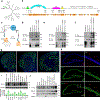ELFN2 is a postsynaptic cell adhesion molecule with essential roles in controlling group III mGluRs in the brain and neuropsychiatric behavior
- PMID: 31485013
- PMCID: PMC6874751
- DOI: 10.1038/s41380-019-0512-3
ELFN2 is a postsynaptic cell adhesion molecule with essential roles in controlling group III mGluRs in the brain and neuropsychiatric behavior
Abstract
The functional characterization of the GPCR interactome has predominantly focused on intracellular binding partners; however, the recent emergence of transsynaptic GPCR complexes represents an additional dimension to GPCR function that has previously been unaccounted for in drug discovery. Here, we characterize ELFN2 as a novel postsynaptic adhesion molecule with a distinct expression pattern throughout the brain and a selective binding with group III metabotropic glutamate receptors (mGluRs) in trans. Using a transcellular GPCR signaling platform, we report that ELFN2 critically alters group III mGluR secondary messenger signaling by directly altering G protein coupling kinetics and efficacy. Loss of ELFN2 in mice results in the selective downregulation of group III mGluRs and dysregulated glutamatergic synaptic transmission. Elfn2 knockout (Elfn2 KO) mice also feature a range of neuropsychiatric manifestations including seizure susceptibility, hyperactivity, and anxiety/compulsivity, which can be rescued by pharmacological augmentation of group III mGluRs. Thus, we conclude that extracellular transsynaptic scaffolding by ELFN2 in the brain is a cardinal organizational feature of group III mGluRs essential for their signaling properties and brain function.
Conflict of interest statement
COMPETING INTERESTS:
The authors declare no competing interests.
Figures





Similar articles
-
Trans-Synaptic Regulation of Metabotropic Glutamate Receptors by Elfn Proteins in Health and Disease.Front Neural Circuits. 2021 Mar 15;15:634875. doi: 10.3389/fncir.2021.634875. eCollection 2021. Front Neural Circuits. 2021. PMID: 33790745 Free PMC article.
-
Synaptic adhesion protein ELFN1 is a selective allosteric modulator of group III metabotropic glutamate receptors in trans.Proc Natl Acad Sci U S A. 2018 May 8;115(19):5022-5027. doi: 10.1073/pnas.1722498115. Epub 2018 Apr 23. Proc Natl Acad Sci U S A. 2018. PMID: 29686062 Free PMC article.
-
Distinct autoregulatory roles of ELFN1 intracellular and extracellular domains on membrane trafficking, synaptic localization, and dimerization.J Biol Chem. 2025 Jan;301(1):108073. doi: 10.1016/j.jbc.2024.108073. Epub 2024 Dec 13. J Biol Chem. 2025. PMID: 39675706 Free PMC article.
-
Postsynaptic Density Proteins and Their Role in the Trafficking of Group I Metabotropic Glutamate Receptors.J Membr Biol. 2024 Dec;257(5-6):257-268. doi: 10.1007/s00232-024-00326-z. Epub 2024 Oct 6. J Membr Biol. 2024. PMID: 39369356 Review.
-
Beyond the Ligand: Extracellular and Transcellular G Protein-Coupled Receptor Complexes in Physiology and Pharmacology.Pharmacol Rev. 2019 Oct;71(4):503-519. doi: 10.1124/pr.119.018044. Pharmacol Rev. 2019. PMID: 31515243 Free PMC article. Review.
Cited by
-
Metabotropic glutamate receptors (mGluRs) in epileptogenesis: an update on abnormal mGluRs signaling and its therapeutic implications.Neural Regen Res. 2024 Feb;19(2):360-368. doi: 10.4103/1673-5374.379018. Neural Regen Res. 2024. PMID: 37488891 Free PMC article. Review.
-
Profiling the Impact of mGlu7/Elfn1 Protein Interactions on the Pharmacology of mGlu7 Allosteric Modulators.ACS Chem Neurosci. 2025 Aug 6;16(15):2872-2886. doi: 10.1021/acschemneuro.5c00174. Epub 2025 Jul 21. ACS Chem Neurosci. 2025. PMID: 40689847 Free PMC article.
-
Deregulated molecules and pathways in the predisposition and dissemination of breast cancer cells to bone.Comput Struct Biotechnol J. 2022 May 30;20:2745-2758. doi: 10.1016/j.csbj.2022.05.051. eCollection 2022. Comput Struct Biotechnol J. 2022. PMID: 35685372 Free PMC article.
-
Defective glycosylation and ELFN1 binding of mGluR6 congenital stationary night blindness mutants.Life Sci Alliance. 2024 Dec 16;8(3):e202403118. doi: 10.26508/lsa.202403118. Print 2025 Mar. Life Sci Alliance. 2024. PMID: 39681475 Free PMC article.
-
Trans-Synaptic Regulation of Metabotropic Glutamate Receptors by Elfn Proteins in Health and Disease.Front Neural Circuits. 2021 Mar 15;15:634875. doi: 10.3389/fncir.2021.634875. eCollection 2021. Front Neural Circuits. 2021. PMID: 33790745 Free PMC article.
References
Publication types
MeSH terms
Substances
Grants and funding
LinkOut - more resources
Full Text Sources
Molecular Biology Databases
Research Materials

